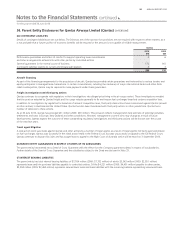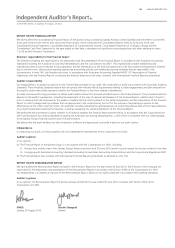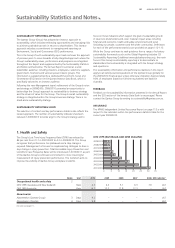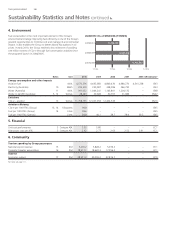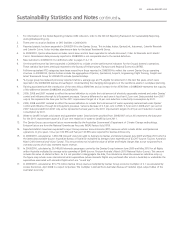Qantas 2010 Annual Report Download - page 114
Download and view the complete annual report
Please find page 114 of the 2010 Qantas annual report below. You can navigate through the pages in the report by either clicking on the pages listed below, or by using the keyword search tool below to find specific information within the annual report.
THE QANTAS GROUP 112
HEALTH AND SAFETY
OHS Lost Time Injury Frequency Rate (LTIFR)
(Australia and New Zealand)
The number of Lost Time Injuries (LTIs) per million hours worked in
Australia and New Zealand from 1 July to 30 June, where an LTI is de ned
as any work related injury or illness that results in the loss of one or more
full days or shifts. LTIFR is used by Qantas Group business units as a
means to compare their own performance both internally and externally.
OHS Serious Injury Frequency Rate (SIFR) (Australia)
The number of workplace injuries resulting in the accumulation of seven
or more total and/or suitable duties days lost per million hours worked in
Australia from 1 July to 30 June. Serious injuries exclude injuries incurred
by employees while travelling for work but outside of work hours and
those incurred while travelling to and from work. Suitable duties days
are de ned as days when an employee has returned to the workplace
following an injury but has speci c restrictions or limitations around the
work they can perform as part of a return to work plan. Serious injuries
are a major driver of workers’ compensation costs.
Absenteeism (Qantas Group)
The average number of annualised days taken as sick leave (including
carer’s leave) per person from 1 July to 30 June for all Australian based
employees and excluding internationally based employees paid locally.
This includes Qantas Airlines, Jetstar, Jetset Travelworld Group, Frequent
Flyer and Corporate Support.
Absenteeism (Qantas)
The average number of annualised days taken as sick leave (including
carer’s leave) per person from 1 July to 30 June for all Australian based
employees and excluding internationally based employees paid locally.
This includes Qantas, QantasLink, Airports, Engineering, Flight Training
and Freight.
CUSTOMER
Domestic on-time arrivals (Australia)
Domestic on-time arrivals are de ned as the percentage of Australian
domestic on-time arrivals for the Qantas Group from 1 July to 30 June.
A ight arrival is counted as on time if it arrived at the gate within
15 minutes of the scheduled arrival time for Sectors own. Neither
diverted nor cancelled ights count as being on time. (Bureau of
Infrastructure, Transport and Regional Economics (BITRE) de nition.)
Domestic on-time departures (Australia)
Domestic on-time departures are de ned as the percentage of Australian
domestic on-time departures for the Qantas Group from 1 July to
30 June. A ight departure is counted as on time if it departed at the
gate within 15 minutes of the scheduled departure time for Sectors
own. Neither diverted nor cancelled ights count as being on time.
(Bureau of Infrastructure, Transport and Regional Economics (BITRE)
de nition.)
Domestic cancellations (Australia)
Domestic cancellations are de ned as the percentage of Australian
domestic cancellations for the Qantas Group from 1 July to 30 June.
A ight is regarded as a cancellation if it is cancelled less than 7 days
prior to its scheduled departure time.
Mishandled bags les per 1,000 passengers
(Qantas and QantasLink)
The number of les lodged for mishandled bags per 1,000 passengers
carried by Qantas and QantasLink domestically and internationally from
1 July to 30 June. A mishandled bag is de ned as any delayed bag for
which a report was led within speci ed time limits.
PEOPLE
Number of full-time equivalent (FTE) employees
The total number of full-time equivalent (FTE) employees as at 30 June,
reported in total for each business unit of the Qantas Group in Australia
and overseas. This is calculated using standard working hours for
full-time and part-time employees and actual hours worked by the
casual and temporary workforce.
Percentage of women
The percentage of all employees of the Qantas Group in Australia and
overseas who are female, at 30 June. Attracting, developing and
retaining women in all areas of the Qantas business remains an ongoing
priority for the Qantas Group.
Percentage of women in senior positions
The percentage of all female employees in senior management positions
across the Qantas Group in Australia and overseas as at 30 June. Senior
positions are de ned as Level 4 (Head of/Manager as de ned by job size)
designator and above.
Percentage of women Directors on the Qantas Board
The percentage of female Directors on the Qantas Board as at 30 June.
Number of women Directors on the Qantas Board
The number of female Directors on the Qantas Board as at 30 June.
Percentage of employees by age group
The percentage by age group of permanent employees for the Qantas
Group in Australia and overseas as at 30 June. Understanding the
changing demographics of the workforce assists in workforce planning.
Percentage of part-time employees
A measure of workforce exibility to report on the percentage of
part-time positions across the Qantas Group in Australia and overseas
as at 30 June.
Number of Indigenous employees
The number of self-identi ed Aboriginal and Torres Strait Islander
employees based on number of employees across the Qantas Group
as at 30 June.
Investment in training
Costs incurred from 1 July to 30 June for employee training including
ight crew training, manpower costs for trainers and instructors,
administrative costs incurred for learning and development activities,
maintenance costs and depreciation on the ight simulators, rent,
maintenance costs and depreciation on the Qantas Centre of Service
Excellence, a facility that the Group established primarily for employee
training purposes. Capital expenditures and opportunity costs such as
employee time spent on in-house training sessions are excluded.
ENVIRONMENT
Aviation fuel consumption
The total volume of aviation kerosene consumed by the Qantas Group’s
ying businesses from 1 July to 30 June. Aviation fuel consumption
includes Qantas, Jetstar, QantasLink, Jetconnect and Freight, for both
domestic and international operations. Aviation fuel consumption does
not include consumption by codeshare partners.
Electricity (Australia)
The total amount of electricity consumed as measured in MWh
(megawatt hours) by Qantas Group sites within Australia where
electricity is separately metered and billed for the period 1 July
to 30 June.
Sustainability Statistics De nitions
Sustainability Statistics and Notes continued



